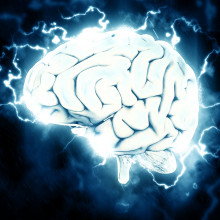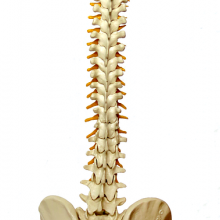Neuralink implant, and a brief history of spine
In the news pod this week, Elon Musk's Neuralink chip is successfully implanted into a human brain, but what's the potential of computer brain interfaces? Also on the programme, an Imperial scientist reveals the reason for insects' attraction to street lights, and we hear about one of the health benefits of fasting. Plus, join us on a sneak preview of a Cambridge museum exhibit all about the evolution of the spine...
In this episode

00:52 - Elon Musk's Neuralink chip implanted into a human
Elon Musk's Neuralink chip implanted into a human
Andrew Jackson, Newcastle University
The billionaire funder of the company Neuralink, Elon Musk, has claimed that the first human has received an implant from the brain-chip startup and is recovering well. The US Food and Drug Administration gave Neuralink permission to test its implant on humans last year. But how might these devices work? I’ve been speaking to Andrew Jackson, who is a professor of neural interfaces at Newcastle University:
Andrew - So they're trying to build a brain computer interface. A brain computer interface is really a device that senses electrical activity in the brain. The brain is an electrical organ, our brain cells communicate by sending bits of electrical information between themselves and if we can place a device into the brain and eavesdrop on that electrical activity, then we can take those signals out and send them to computers or assistive devices that could be helpful for people who are paralysed.
Chris - How far along this path has science, technology and medicine already advanced?
Andrew - The idea of communicating directly between our brains and technology has been around in science fiction for many years. The field really started accelerating around the turn of the millennium, and a study in the US started using electrode arrays in people for this brain computer interface idea. They started with fairly simple applications where people were controlling cursors, moving around on a computer screen. Over the years, that's developed into controlling robotic arms, and now some of the latest demonstrations involve converting brain signals into speech and language so people who are unable to speak can communicate using a voice synthesiser based on decoding their thoughts from their brain. It's worth pointing out that the accuracy of this process, the performance of these brain computer interfaces, still has some way to go to match our natural ability to move our hand or speak. The performance is slow, but as the algorithms for decoding brain activity improve, and as the technology for recording these electrical signals from more and more brain cells improves, there's significant promise that these devices could be useful for helping people who have disabilities.
Chris - And practically speaking, what's involved in doing this? When we are listening to the electrical activity of different bits of the nervous system, that is just spikes of electricity. So how is that turned into something that means something to a computer and then ultimately into the action that you want to do?
Andrew - That's a process called decoding. The easiest way to think about it, it's a little bit like counting votes in an election. The first thing you have to do is to ask the user of the device to imagine making, say, two different movements: a movement to the left and a movement to the right. Different brain cells will have preferred directions, so some brain cells will be much more active when I imagine a movement to the right and some brain cells will be much more active when I make a movement to the left. And so by counting up the votes, in a way, that each brain cell is making for its preferred direction, you can infer that the population as a whole was involved in imagining a movement to the left or to the right. As you get more complicated, decoding movements in three dimensions or trying to decode language, this process obviously gets more difficult.
I think it's one of the main limitations at the moment of the field, that in order to use these devices, the user first has to go through this process of training the algorithm to recognise what patterns of brain activity are associated with the different instructions or ideas that the interface is trying to decode. There's an interesting question in here, which is, how similar is your brain to my brain? When you think of a cat, does the same kind of pattern of activity occur in your brain as in mine when I think of a cat? And I think these are going to be some of the fundamental questions that the field is going to come up against, is can we extend this concept to decoding much more complicated ideas from brains, or are we always going to be limited to these relatively simple applications where it's moving a cursor around on a screen or something like that?
Chris - Everything we've discussed so far has been very much a one way street: taking information out of the brain. Is there ultimate aspiration that we can put information in, in some way, or send signals back? And what would be the application or the purpose of doing something like that?
Andrew - Well, we're already doing that to some extent with devices like cochlear implants used by some people who are deaf and, there, information about sound is being electrically transmitted into the auditory nerve and sent to the brain and is perceived as sound. You can think of perhaps doing something similar with blindness where we may be able to send information into the retina or potentially the visual cortex in the brain that could be perceived by the brain as visual information. Certainly, these applications are starting to be explored. There's also potentially more interesting stuff we may be able to do in the future by interfacing in both directions with circuitry within the brain that is supporting some of the more complex cognitive functions that our brain does. So people speculate as to whether we could improve people's memory, say, by sensing signals from memory circuits, but also putting information into those memory circuits. I think the problem is that as we get towards those kinds of applications, we know relatively less about how the brain is doing it already, and therefore it becomes more difficult to see how, using these kinds of technologies anytime soon, we'll be able to improve these more cognitive functions.
Chris - Are you looking forward to being a cyborg one day?
Andrew - I'm always interested in these technologies. I think that what we'll really be seeing over the coming years and decades as these technologies become more sophisticated is that we can really start to get at some of the really interesting scientific potentials of what we can do with a direct interface between the brain and technology. I'm hoping that the applications will become more than just moving cursors around on a computer screen, but I'm fascinated to see how the field develops.

07:34 - Why insects are attracted to light
Why insects are attracted to light
Samuel Fabian, Imperial College London
Now most of us will have noticed that artificial lights at night seem to attract insects like bees around a honeypot, if that’s the right analogy! We didn’t know why though, other than perhaps the insects might be mistaking street lights for the sun and trying to navigate by them. Now though, with the help of some extremely fast photography, Sam Fabian, from Imperial College London, thinks he’s got to the bottom of it...
Samuel - The question that was really interesting to us is why, when you put a light out at night, do you get insects showing up? It's something that I think pretty much every human being on Earth has seen. The trouble was that a lot of the explanations, and a lot of the discussion around it just didn't seem to match our understanding of how insects operate. They just didn't seem quite satisfying. So we thought, well, what's the data? It actually turned out there wasn't that much data about the way in which insects were flying around lights at night.
Chris - And you're right about the ubiquity of this because I think I've certainly read references back in, I think Greek mythology, where people are referring to insects being drawn like a moth to a flame. What have people speculated might be going on.
Samuel - There are quite a few theories. A few of them were things like, insects are inherently attracted to heat. We actually now know that's not really true, or at least that's not the effect that's causing this. You can stick an LED out that chucks out far less thermal radiation and yet you still get lots and lots of insects showing up. There were other theories that it was something to do with trying to escape to where they saw bright spots because they thought it was like looking through the trees at a patch of light and they were heading for that. But actually, when we look at the trajectories of insects, they don't tend to fly around in direct lines straight towards the light. In fact, they assume these weird circuitous, roundabout paths that lead them in towards the light.
Chris - How did you test it, then? Did you set up a bonfire or bright lights? What was the experimental setup, and how did you actually see, in an objective way, what the insects are really doing?
Samuel - The way that we approached that first question, is it this compass cue, which we eventually ruled out, one way in which we approached this was that if you're using something as a sort of landmark reference and you are keeping it at a certain region, you should want it to either be on the right or the left of your body, most likely. Well, if we turn that light off and we turn a new light on at exactly the same time you should, after a little bit of confusion in the middle, start circling this other light in the same direction because you should always want the light to stay on your left. But actually, when I sat there and toggle in these lights, we found that they would actually change which direction they were circling around the light, they would change having the light on their left or having the light on their right. And they didn't seem to care which side it was on, which really argues against this compass cue. And the lights in this instance were UV LED bulbs. We would hang these around and we could see the way in which the insects would fly around it and then would record these with high speed cameras. So these are things that are able to take pictures at 500 to 1000 frames per second.
Chris - And when you did that, did anything emerge from these pictures that enabled you to explain why the insects appear to have a bad sense of direction that they flip when you flick the lights on and off? What are they actually doing? They're clearly not worried about right and left or they would've done exactly as you suggested and circled in one direction. So what are they doing?
Samuel - I think it really clicked when I had this beautiful underwing moth, and it sat on my hand and I got it to take off and we had this UV light that was shining upwards. What happens is the moth would cruise over the UV light and as soon as it was over and above that UV bolt, it flipped itself upside down and dropped out of the air. That is not matched by any explanation or any theory that we currently have. Actually, we know about a behavioural response where animals tilt their backs towards light because they think the light is the direction of up because they think that's the sky. The sky has been, for 370 million years while insects have been flying around, the brightest region that they can see. So if you just assume the bright region is the sky and therefore up, you can very quickly work out which way is up. Using where is bright to work out which way is up is a really robust, simple, beautiful way to solve this problem. It's a really great way to do it until somebody invents street lights, at which point it's suddenly not such a good idea.
Chris - So putting all this together, then, you would argue that what is happening when that moth or that insect goes to the streetlight at night is that they see this as a light source that they then think, that is the sky, and they then continuously orientate themselves so that their back is towards the light. But why does that make them go round in a circle?
Samuel - If they're constantly tilting their back towards the light, well, on average they should think that gravity or gravitational acceleration should be pulling them in the other direction. If they're tilting their backs over, it's a bit like if you had a helicopter or a plane and you just tilted it over. All of a sudden, those forces are asymmetrical, and that leads the animal drifting around. That drift is dependent on where it is relative to light. But what happens is they get locked in these very circular orbits, especially if there's very little wind and you have a very stable flight. Something like a dragonfly, you can get really, tight beautiful circles of about 60 centimetres in diameter if they fly around, that's because the body is rolled over to one side of their flying. It's creating asymmetry in which way the flight forces are going, causing them to constantly turn. As they turn, the light moves relative to them and they keep adjusting for that and they just get stuck in this pile.
Chris - So is there anything you can do to help me with the blue bottle in my bedroom that won't stop when I want to go to bed at night? Is there anything I can do to lure it away better?
Samuel - Certainly we can think about ways in which we can lure this away better. What seems to be important is that wavelength is super key. Wavelength is really just the colour of the lights and that's important because we find that things like UV are very important and they work on lots of different insects. But we also think about this in the other way: how do we have lights at night that don't influence insects? For those of us that love bugs and those of us that don't, we should care about them and we should want to not influence their behaviour. This tells us that actually the direction in which we're putting out lights is really important and that we shouldn't have lights that are just shining up into the atmosphere or shining out sideways if we want to try and restrict our effects on insects at night.

14:35 - Back in time: Exhibit charts history of vertebrates
Back in time: Exhibit charts history of vertebrates
Jason Head, University of Cambridge
A fascinating exhibition by the University of Cambridge’s Museum of Zoology has just opened to the public. It’s called Growing a backbone: Rise of the vertebrates and our very own Will Tingle went along for a spine-tingling preview…
Will - My gym teacher always told me to grow a spine, so today I'm taking his advice and heading down to Cambridge University's Museum of Zoology to meet the man who can tell me all about the virtues of growing a backbone.
Jason - I am Jason Head. I am the curator of vertebrate palaeontology in the University Museum of Zoology at the University of Cambridge, and I'm the professor of vertebrate evolution and ecology in the Department Zoology at Cambridge.
Will - Do we know roughly when the first vertebrate may have come about and what it might have looked like?
Jason - So the oldest fossil vertebrates tell us that the group originates at least by what we would call the early to middle Cambrian. This is going to be somewhere around 520, 530 million years ago.
Will - Why a backbone, though? What about it is so beneficial to those that have one that has allowed such a wide variety of species to evolve?
Jason - The backbone, or the spine, or the vertebral column is a really important structure in vertebrate evolution. When we evolve this multi segmented series of bones that connect together and can bend and twist, we evolve massive body sizes. We can climb, we can swim, we can crawl, we can support ribs, we can support our organs with them. So the vertebral column, the spine, is what we like to call the central axis of the vertebrate body, but it's also the central axis of vertebrate evolution.
Will - As we are looking out here across all these organisms across a great span of time, one thing that strikes me is the fact that you've had to study vertebrates by purely looking at fossil records and the fossil record would imply, if I looked at it, that the spine was just a series of bones. How do you make such assumptions based on just the fossil records that you have?
Jason - The nice thing about bones is that their shapes, their anatomies, their features give us clues about the soft tissues that they're integrated with, that they connect to. So we can know things about the spinal cord by looking at the passages in the bone that the spinal cord passes through, we can tell about the muscles that connect the various bones of the backbone by the attachment sites on the various vertebrae. We do use the fossil record, it's invaluable and it's a necessary component to understanding vertebrae evolution, but we can also look at how the embryological development in living vertebrates occurs and we can see how everything from the genetics that control how vertebrae are patterned to the various ways in which the animals grow and the rate and the speed and how many vertebrae they develop. All of this integrates with the fossil record and then the morphology or the anatomy of living vertebrates to give us a complete picture of how we became this dominant group in terms of ecology, diversity and body size today.
Will - Are there any particular highlights, any favourites that you'd love to walk me through?
Jason - Sure. We can start over here if you want. This is the skeleton of about a three and a half metre long Burmese python. It's one of the largest snake species in the world. What we've done is we've laid the specimen out so that it's in a straight line and we have the spine running straight behind the skull and then the ribs are laid out on either side of this specimen. What we wanted to do is show how the spine changes along the body of a snake and how the ribs change, but also to really accentuate how many individual bones make up the spine of a snake, which is hundreds. That's a really interesting feature of these animals, and we know that evolutionary changes in how they develop as embryos are what led to this increase in the number of bones in the spine. Many snakes do actually keep hind legs. They actually have a femur, a thigh bone and, based on work by one of our postgraduate students here in the museum, we've discovered that some snakes actually have the shin bones, the tibia, and the fibula, still. The interesting thing about the hind legs in snakes is that those snakes that retain them actually use them in mating. A male snake will crawl up next to a female snake and the thigh bone still sticks out of the body, it has a little keratinous covering (keratin being the stuff that our fingernails are made out of) and these little legs are really powerful, and so they can vibrate them really quickly against the side of the female's body. That indicates that the male is ready to mate
Will - And they say romance is dead. This final one, I think I recognise this, but I'm going to be very embarrassed if I get this wrong. This looks awfully like a skull of my own.
Jason - Yeah. This is a human skull and we have it in a case with the skull of a crocodile, and we have it with some birds and sheep and a snake. These skulls are actually built and arranged on a particular type of armature where the skulls are what we call exploded. All the bones are close to each other and in position, but they're all on separate rods so you can see how they fit together. This was actually a Victorian teaching tool, and what we've done is we've used these specimens to illustrate a point about the evolution of special features of vertebrates, specifically how vertebrates evolve a face. If you grab the top of your head with one hand and grab your face with the other hand, you're going to be holding two different types of tissue, two different types of bone, that actually don't have exactly the same evolutionary history.
Jason - Our face is composed of bone that is derived from a special cell type called neural crest. Neural crest is a unique feature of vertebrates. It forms parts of the connective tissues of our sensory systems that could link them to the brain, but it also forms the bones of our face and the bones of our collar bones. The senses in your face and their supports in the bones of the skull are all derived from this unique feature called neural crest. What we've done is, by having these exploded skulls, we've not only been able to use a Victorian teaching tool, we've been able to use it to show a new discovery and development that is really a mid 20th century innovation.
Will - Thank you so much for showing me around. This is absolutely fascinating. I feel like we only touched the surface of what's available at this exhibit. We've talked about backbones and we've talked about jaws, but what else is there for people to enjoy if they come along?
Jason - One of the exhibits we also have is an exhibit that talks about the origin of vertebrates moving from water to land. This was pioneering work done by my predecessor in the museum, Professor Jenny Clack. Anyone who wants to come to the museum and discover how we went from fish in the water to tetrapods on land, and how we went from fins to limbs, can come on up and see those specimens and you can hear about that research.
Will - I'll be there, day one, first in the queue.

21:07 - Fasting reduces bodily inflammation
Fasting reduces bodily inflammation
Clare Bryant, University of Cambridge
We learned this week that the Prime Minister, Rishi Sunak, undertakes a fast at the start of every week, consuming only water, tea or black coffee from 5pm on a Sunday to 5am on Tuesday. But could this enforced 36 hours of what most of us would regard as hell, have health benefits? Cambridge University Immunologist Claire Bryant has published a paper this week that suggests Rishi Sunak might be on to something. Fasting, she's found, drives down levels of inflammation in the body, by pushing up the concentration of a chemical called arachidonic acid. This, she's found, blocks an inflammatory pathway that can be linked to a host of diseases and accelerated ageing. Aspirin also targets it, which might be one of the ways that the painkiller exerts its therapeutic effects...
Claire - We were really interested in the beneficial effects of fasting. People that overeat or have the western diet, the high fat diet, that led to an increase in the activity of an inflammatory complex called the inflammasome. We were interested because fasting people seem to have the reverse
Chris - Indeed because people who calorie restrict are said to live longer, aren't they?
Claire - Yeah, they are. They seem to have all sorts of other health benefits as well and it's completely reversed for people who are on a high fat western diet. So, why? That was the question. What does it mean and how does it work?
Chris - How did you pursue it?
Claire - Two things. There was a happy coincidence, actually. We had started to do some work in the lab and we were looking at, in our models, what sorts of lipids were being produced. And there was a particular profile of lipids which was totally unexpected. One of them, a lipid called arachidonic acid, which normally I would associate with an inflammatory state, was actually elevated.
Chris - That is weird because that's the starting material for making a whole load of inflammatory chemicals in the body. So it seems paradoxical that, in people with low levels of inflammation, they should have high levels of the starting material? Is that just because they're not using it to make the inflammatory materials?
Claire - That was what we thought, and that was certainly what the data we were seeing in our in vitro models were suggesting.
Chris - Putting this together then, we calorie restrict by some mechanism, this puts up the level of arachidonic acid, which turns down this inflammasome, the inflammatory complex that we know maps onto being less healthy. How does the calorie restriction push up the arachidonic acid so that you end up with less inflammation? What's going on?
Claire - Well, that's the million dollar question. In fact, what's also interesting, I've been thinking about this a lot, is how long do you need to fast? What fasting regime do you need to undertake? How many days a week, one day a week? Rishi Sunak's 36 hours? Is that the ideal way or is it short, long? There's a whole bunch of questions here that we now need to further investigate, and because we can find the arachidonic acid, obviously we can track this over time, we can map this against the inflammatory markers and see exactly what happens. But the honest answer is, this is one of the first steps in the puzzle to understand this direct switch between arachidonic acid and inflammasome activity.
Chris - The other thing that's interesting with this is, if people take aspirin for things like heart disease, they also get benefits in other things like cancers, Alzheimer's disease, other degenerative states. People have said this is because it stops the inflammation. What does aspirin do to arachidonic acid?
Claire - So aspirin inhibits the breakdown of arachidonic acid. So, one of the things we think as well, that this work has shown, is that there's yet another way in which drugs like aspirin are anti-inflammatory because the arachidonic acid is not broken down, this can then feed back to inhibit the inflammasome activity, and that will then decrease your inflammation. Aspirin is a many functional drug and the longer we do the research, the more effects and mechanisms we find in these drugs.

25:13 - How can languages of bordering countries be so different?
How can languages of bordering countries be so different?
Will Tingle asked David Crystal for the answer...










Comments
Add a comment